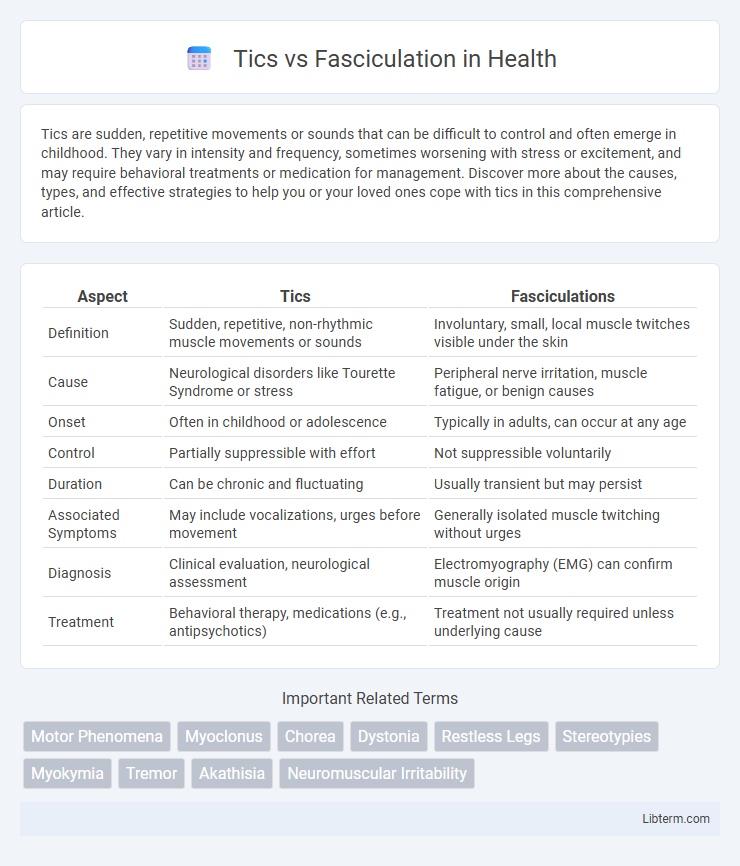Tics are sudden, repetitive movements or sounds that can be difficult to control and often emerge in childhood. They vary in intensity and frequency, sometimes worsening with stress or excitement, and may require behavioral treatments or medication for management. Discover more about the causes, types, and effective strategies to help you or your loved ones cope with tics in this comprehensive article.
Table of Comparison
| Aspect | Tics | Fasciculations |
|---|---|---|
| Definition | Sudden, repetitive, non-rhythmic muscle movements or sounds | Involuntary, small, local muscle twitches visible under the skin |
| Cause | Neurological disorders like Tourette Syndrome or stress | Peripheral nerve irritation, muscle fatigue, or benign causes |
| Onset | Often in childhood or adolescence | Typically in adults, can occur at any age |
| Control | Partially suppressible with effort | Not suppressible voluntarily |
| Duration | Can be chronic and fluctuating | Usually transient but may persist |
| Associated Symptoms | May include vocalizations, urges before movement | Generally isolated muscle twitching without urges |
| Diagnosis | Clinical evaluation, neurological assessment | Electromyography (EMG) can confirm muscle origin |
| Treatment | Behavioral therapy, medications (e.g., antipsychotics) | Treatment not usually required unless underlying cause |
Understanding Tics and Fasciculations
Tics are sudden, repetitive, involuntary movements or vocalizations often linked to neurological conditions like Tourette syndrome, characterized by their semi-voluntary nature and ability to be temporarily suppressed. Fasciculations are spontaneous, fine muscle twitches caused by involuntary contractions of muscle fibers, commonly associated with nerve irritation or disorders such as amyotrophic lateral sclerosis (ALS). Differentiating tics from fasciculations involves recognizing the origin: tics originate from abnormal brain activity affecting motor control, while fasciculations stem from peripheral nerve disturbances affecting muscle fibers.
Defining Tics: Characteristics and Symptoms
Tics are sudden, repetitive, non-rhythmic motor movements or vocalizations characterized by their typically involuntary nature and brief duration. Common symptoms include eye blinking, facial grimacing, shoulder shrugging, or throat clearing, often preceded by an urge or sensation that is temporarily relieved by performing the tic. Unlike fasciculations, which are involuntary muscle twitches caused by nerve irritation or damage, tics are often influenced by stress and can be suppressed temporarily but not eliminated.
What Are Fasciculations? Key Features
Fasciculations are involuntary, fine muscle twitches caused by spontaneous activation of muscle fibers, often visible under the skin. They typically result from irritation or damage to the motor neurons or muscle fibers and may be associated with conditions like benign fasciculation syndrome or more severe neurological disorders. Key features include rapid, irregular, painless twitches that do not produce muscle movement and are distinct from the repetitive movements seen in tics.
Common Causes of Tics
Tics are involuntary, repetitive movements or sounds often triggered by neurological or psychological factors such as Tourette syndrome, stress, or anxiety, distinguishing them from fasciculations, which are fine muscle twitches generally caused by nerve irritation or muscle fatigue. Common causes of tics include genetic predisposition, neurodevelopmental disorders, and environmental stressors that affect motor control pathways in the brain. Understanding these causes is essential for accurate diagnosis and targeted treatment strategies in managing tic disorders.
Triggers and Origins of Fasciculations
Fasciculations originate from spontaneous involuntary muscle fiber contractions linked to nerve irritation or damage, often triggered by stress, fatigue, caffeine intake, or electrolyte imbalances. Unlike tics, which are sudden, repetitive movements driven by neurological or psychological factors, fasciculations stem from peripheral nerve hyperexcitability. Understanding these distinct triggers helps differentiate fasciculations as primarily neuromuscular phenomena, whereas tics involve central nervous system dysfunction.
Clinical Differences: Tics vs Fasciculations
Tics are sudden, repetitive, non-rhythmic movements or vocalizations often preceded by a premonitory urge and temporarily suppressible, commonly seen in conditions like Tourette syndrome. Fasciculations are involuntary, fine, flickering muscle twitches arising from spontaneous motor unit discharges, typically painless and unrelated to voluntary control, often observed in motor neuron diseases such as amyotrophic lateral sclerosis. Clinically, tics involve more complex, purposeful patterns and associated sensory phenomena, whereas fasciculations are isolated muscle fiber contractions without behavioral triggers or suppressibility.
Associated Conditions and Risk Factors
Tics are commonly associated with neurological disorders such as Tourette syndrome and attention-deficit/hyperactivity disorder (ADHD), often linked to genetic predisposition and stress. Fasciculations are typically related to motor neuron diseases like amyotrophic lateral sclerosis (ALS) or peripheral nerve irritation, with risk factors including nerve injury and electrolyte imbalances. Differentiating these conditions requires understanding their underlying causes, as tics frequently involve repetitive, suppressible movements, whereas fasciculations are involuntary muscle twitches due to nerve hyperexcitability.
Diagnosis: How Doctors Differentiate
Doctors differentiate tics from fasciculations by analyzing clinical features, with tics being sudden, repetitive, suppressible movements or sounds often triggered by an urge, whereas fasciculations are involuntary muscle twitches localized to muscle fibers without associated movements or urges. Electromyography (EMG) assists in diagnosis by detecting spontaneous motor unit discharges in fasciculations, unlike the cortical-driven activity seen in tics. Patient history and neurological examination remain essential for identifying underlying causes and distinguishing between these movement disorders.
Treatment Approaches for Tics and Fasciculations
Treatment approaches for tics often involve behavioral therapy such as Comprehensive Behavioral Intervention for Tics (CBIT) and pharmacological options like antipsychotics or alpha-2 adrenergic agonists. Fasciculations usually do not require specific treatment unless associated with an underlying neurological disorder, in which case addressing the root cause is essential. Symptomatic management for fasciculations may include medications such as muscle relaxants or magnesium supplements to reduce discomfort.
When to Seek Medical Advice
Seek medical advice for tics if they persist beyond one year, worsen in frequency or intensity, or significantly interfere with daily activities or social interactions, as these may indicate a chronic tic disorder such as Tourette syndrome. Consult a healthcare professional for fasciculations if muscle twitches are accompanied by muscle weakness, atrophy, or other neurological symptoms, as these signs may suggest an underlying condition like amyotrophic lateral sclerosis (ALS) or peripheral neuropathy. Early evaluation by a neurologist is crucial to differentiate benign tics from fasciculations linked to serious neuromuscular disorders.
Tics Infographic

 libterm.com
libterm.com